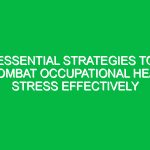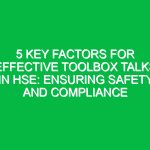In today’s world, where health, safety, and environmental (HSE) concerns are paramount, the importance of a comprehensive personal protective equipment list cannot be overstated. Personal protective equipment (PPE) serves as a critical barrier between workers and various hazards they may encounter in their work environments. This article delves into the essential components of a personal protective equipment list, emphasizing its relevance in the HSE domain and providing insights into best practices, regulations, and real-life implications.
Understanding Personal Protective Equipment (PPE)
Personal protective equipment encompasses a wide range of gear designed to protect individuals from health and safety risks. These risks can vary significantly across industries—from construction and manufacturing to healthcare and laboratory settings. PPE acts as a line of defense against potential hazards such as chemicals, noise, physical impacts, biological agents, and even respiratory threats.
The relevance of a personal protective equipment list in the HSE context lies in its ability to ensure that all employees have access to the necessary tools to mitigate risks. An effective PPE list not only lists the equipment required but also provides guidelines on proper usage, maintenance, and training. This article aims to equip organizations and individuals with the knowledge needed to develop a robust PPE list tailored to their specific needs.
Key Components of a Personal Protective Equipment List
Creating a personal protective equipment list involves identifying the specific needs based on the tasks performed and the potential hazards present. Here are the essential categories of PPE to consider:
1. Head Protection
- Hard Hats: Essential for protecting against impact and penetration hazards.
- Helmet Accessories: Face shields and earmuffs can be attached for added protection.
2. Eye and Face Protection
- Safety Glasses: Designed to prevent eye injuries from flying debris.
- Goggles: Offer a secure shield against chemicals and hazardous materials.
- Face Shields: Protect the entire face from chemical splashes or flying objects.
3. Hearing Protection
- Earmuffs: Provide protection in noisy environments.
- Earplugs: Easy to use and can be disposable or reusable.
4. Respiratory Protection
- Respirators: Essential for environments with airborne contaminants.
- Dust Masks: Provide basic protection against nuisance dust.
5. Hand Protection
- Gloves: Different types offer varying degrees of protection against chemicals, cuts, and heat.
- Barrier Creams: Help protect skin from exposure to harmful substances.
6. Foot Protection
- Safety Boots: Steel-toed boots offer protection against heavy objects.
- Slip-Resistant Shoes: Essential in preventing slips and falls.
7. Body Protection
- High-Visibility Clothing: Ensures workers are seen in low-light conditions.
- Protective Suits: Used in hazardous environments to prevent exposure.
8. Fall Protection
- Safety Harnesses: Crucial when working at heights.
- Guardrails and Safety Nets: Provide additional layers of safety.
Assessing Hazards and Risks
To develop an effective personal protective equipment list, it is crucial to first assess the workplace for potential hazards. Conducting a thorough risk assessment involves identifying not only the hazards present but also understanding the level of risk associated with each. This can include:
- Identifying potential physical hazards (e.g., falling objects, machinery).
- Recognizing chemical hazards (e.g., spills, exposure to toxic substances).
- Understanding biological hazards (e.g., exposure to infectious materials).
- Assessing ergonomic risks (e.g., repetitive strain injuries).
A comprehensive risk assessment informs the selection of appropriate PPE, ensuring that employees are adequately protected based on the specific risks they face in their work environment.
Best Practices for Personal Protective Equipment Usage
Having a personal protective equipment list is only one part of the equation. For HSE success, organizations must also implement best practices for PPE usage:
- Training: Regular training sessions should be conducted to ensure that employees understand the importance of PPE and how to use it correctly.
- Regular Inspections: PPE should be inspected regularly to check for wear and tear. Damaged equipment should be replaced immediately.
- Maintenance: Proper maintenance of PPE extends its lifespan and ensures it provides adequate protection.
- Employee Involvement: Employees should be encouraged to provide feedback on the effectiveness of PPE and any issues they face while using it.
Real-Life Implications of PPE
Consider the story of a construction site in a bustling urban area. One day, a worker named John was on-site when a heavy tool fell from a height. Fortunately, he was wearing a hard hat, which absorbed the impact and prevented a serious injury. This incident emphasizes the critical role PPE plays in protecting workers from unforeseen hazards. Such anecdotes are not just stories; they are reminders of the importance of adhering to a well-curated personal protective equipment list.
Regulations and Standards Governing PPE
Compliance with regulations and standards is another vital aspect of personal protective equipment. In many countries, several regulations govern the use of PPE, including:
- Occupational Safety and Health Administration (OSHA): In the United States, OSHA mandates that employers provide appropriate PPE based on the hazards present in the workplace.
- Personal Protective Equipment at Work Regulations: In the UK, these regulations require employers to ensure that PPE is suitable for the risks involved.
- European Union Standards: Various directives outline specific requirements for PPE across member states.
Understanding these regulations is critical, as non-compliance can lead to severe penalties and, more importantly, increased risks to worker safety.
Conclusion
In conclusion, a well-thought-out personal protective equipment list is not just a checklist; it is a fundamental component of promoting health, safety, and environmental sustainability in the workplace. By assessing hazards, implementing best practices, adhering to regulations, and fostering a culture of safety, organizations can significantly reduce the risks faced by their employees.
As we move forward in a world where workplace safety is increasingly prioritized, it is essential to continuously evaluate and update personal protective equipment lists to reflect the changing landscape of occupational hazards. In doing so, we not only protect our workforce but also lay the groundwork for a safer, healthier work environment for all.


